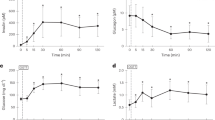Abstract
Food intake is believed to be partially controlled by hepatic signals related to adenosine triphosphate (ATP) status. We hypothesized that increased phosphorus content of one meal can stimulate hepatic ATP synthesis of the next meal, which in turn contributes to satiation. This hypothesis was tested by measuring the energy intake after phosphorus addition to several preloads. The phosphorus content of the different preloads was found to be inversely related to the energy intake at a subsequent meal, although the exact mechanism behind such effects was not studied. Such findings point to a potential role for phosphorus in the control of food intake.
This is a preview of subscription content, access via your institution
Access options
Subscribe to this journal
Receive 12 print issues and online access
$259.00 per year
only $21.58 per issue
Buy this article
- Purchase on Springer Link
- Instant access to full article PDF
Prices may be subject to local taxes which are calculated during checkout
Similar content being viewed by others
References
Friedman MI . Obesity and the hepatic control of feeding behavior. Drug News Perspect 2007; 20: 573–578.
Langhans W, Scharrer E . Metabolic control of eating. World Rev Nutr Diet 1992; 70: 1–67.
Riquelme PT, Wernette-Hammond ME, Kneer NM, Lardy HA . Mechanism of action of 2, 5-anhydro-D-mannitol in hepatocytes. J Biol Chem 1984; 259: 5115–5123.
Rawson NE, Ulrich PM, Freidman MI . L-ethionine, an amino acid analogue, stimulates eating in rats. Am J Physiol 1994; 267: R612–R615.
Hong J, Graczyk-Milbrandt G, Friedman MI . Metabolic inhibitors synergistically decrease hepatic energy status and increase food intake. Am J Physiol Regulatory Integr Comp Physiol 2000; 278: R1579–R1582.
Bray GA, Nielsen SJ, Popkin BM . Consumption of high-fructose corn syrup in beverages may play a role in the epidemic of obesity. Am J Clin Nutr 2004; 79: 537–543.
Bizeau ME, Pagliassotti MJ . Hepatic adaptations to sucrose and fructose. Metab: Clin Exp 2005; 54: 1189–1201.
Oberhaensli RD, Galloway GJ, Taylor DJ, Bore PJ, Radda GK . Assessment of human liver metabolism by phosphorus-31-magnetic resonance spectroscopy. Br J Radiol 1986; 59: 695–699.
Morris Jr RC, Nigon K, Reed E . Evidence that the severity of depletion of inorganic phosphate determines the severity of the disturbance of adenine nucleotide metabolism in the liver and renal cortex of the fructose-loaded rat. J Clin Invest 1978; 61: 209–220.
Akhavan T, Anderson H . Effects of glucose-to-fructose ratios in solutions on subjective satiety, food intake, and satiety hormones in young men. Am J Clin Nutr 2007; 86: 1354–1363.
Stunkard AJ, Messick S . The three-factor eating questionnaire to measure dietary restraint, disinhibition and hunger. J Psychosom Res 1985; 29: 71–83.
Rawson NE, Freidman MI . Phosphate loading prevents the decrease in ATP and increase in food intake produced by 2,5-anhydro-D-mannitol. Am J Physiol 1994; 266: R1792–R1796.
Nair S, Chacko VP, Arnold C, Diehl M . Hepatic ATP reserve and efficiency of replenishing: comparison between obese and nonobese normal individuals. Am J Gastroenterol 2003; 98: 466–470.
Cortez-Pinto H, Chatham J, Chacko VP, Arnold C, Rashid A, Diehl AM . Alterations in liver ATP homeostasis in human nonalcoholic steatohepatitis: a pilot study. JAMA 1999; 282: 1659–1664.
Lindgarde F, Trell E . Serum inorganic phosphate in middleaged men. I. Inverse relation to body weight. Acta Med Scand 1977; 202: 307–311.
Wlodek D, Gonzales M . Decreased energy levels can cause and sustain obesity. J Theor Biol 2003; 225: 33–44.
Teegarden D . The influence of dairy product consumption on body composition. J Nutr 2005; 135: 2749–2752.
Halton TH, Hu FB . The effects of high protein diets on thermogenesis, satiety and weight loss: a critical review. J Am Coll Nutr 2004; 23: 373–385.
Acknowledgements
We thank the following students for their support in the recruitment and execution of the different experiments: L Hamoud, R Kamal, R Housari, T Tabbakh, M Al-Dirani and F Mazloum.
Author information
Authors and Affiliations
Corresponding author
Ethics declarations
Competing interests
The authors declare no conflict of interest.
Rights and permissions
About this article
Cite this article
Obeid, O., Dimachkie, S. & Hlais, S. Increased phosphorus content of preload suppresses ad libitum energy intake at subsequent meal. Int J Obes 34, 1446–1448 (2010). https://doi.org/10.1038/ijo.2010.74
Received:
Revised:
Accepted:
Published:
Issue Date:
DOI: https://doi.org/10.1038/ijo.2010.74
Keywords
This article is cited by
-
Effect of phosphorus supplementation on weight gain and waist circumference of overweight/obese adults: a randomized clinical trial
Nutrition & Diabetes (2015)
-
Refeeding and metabolic syndromes: two sides of the same coin
Nutrition & Diabetes (2014)



